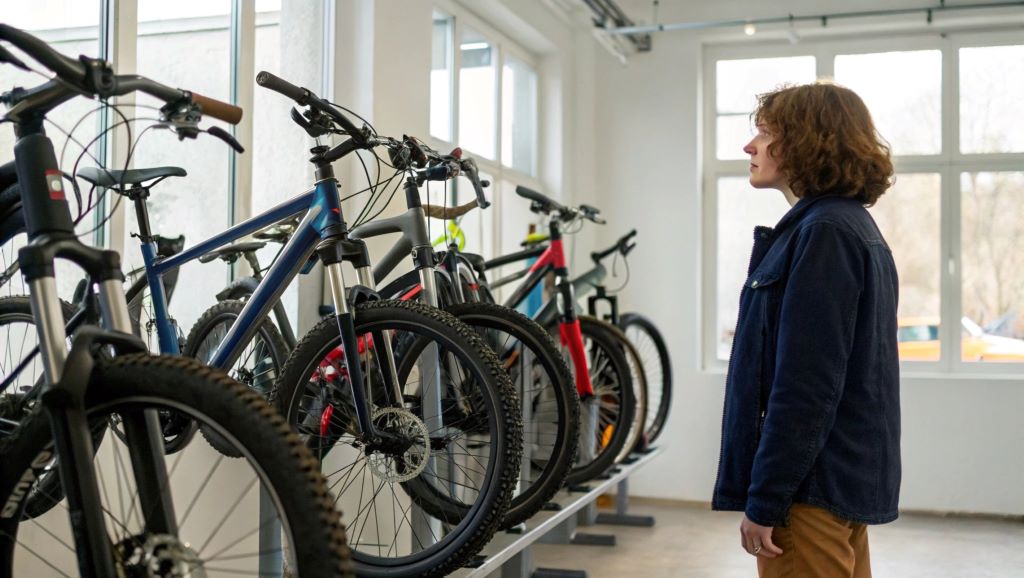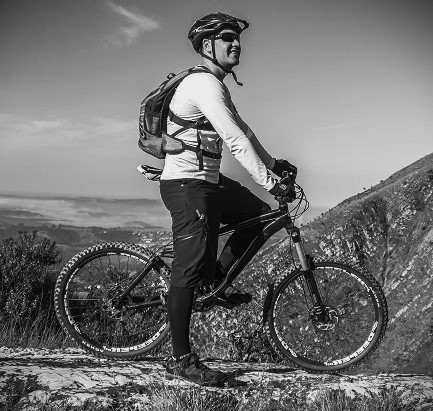The thrill of speeding down a rugged trail, wind rushing past, is unmatched. Choosing the best mountain bike can transform your adventures, whether you’re a beginner or a seasoned rider. My first ride on a mountain bike was a game-changer; the right bike made every trail feel conquerable. With so many options, finding the perfect bike feels daunting. According to a 2023 study by Outdoor Industry Association, mountain biking participation grew by 12% in the U.S., showing its rising popularity. This guide, packed with practical tips, will help you navigate bike types, features, and more to ensure you pick the best mountain bike for your journey.
Understanding Mountain Bike Types
Mountain bikes come in various types, each suited for specific terrains. Cross-country bikes are lightweight, ideal for long climbs and fast trails. Trail bikes, versatile and balanced, handle diverse landscapes well. Downhill bikes, built for steep descents, prioritize durability. All-mountain bikes blend climbing and descending capabilities, perfect for mixed trails. Freeride bikes focus on jumps and tricks, appealing to stunt enthusiasts.
Choosing the right type depends on your riding style. For instance, I started with a trail bike, which offered flexibility for my local rocky paths. A 2022 report by Singletracks found 45% of riders prefer trail bikes for their adaptability. Consider where you’ll ride most—smooth trails or rugged mountains—to narrow your options. Each type enhances your experience, so align your choice with your adventure goals.
Key Features to Look for in a Mountain Bike
When selecting the best mountain bike, focus on critical features like frame material, suspension, and wheel size. Aluminum frames are lightweight and affordable, while carbon frames offer strength but cost more. Suspension types—hardtail or full-suspension—affect comfort. Hardtails, with front suspension only, suit smoother trails. Full-suspension bikes absorb shocks on rough terrain, ideal for aggressive riding.
Wheel sizes, like 27.5-inch or 29-inch, impact speed and control. Larger wheels roll faster but may feel less agile. My trail bike’s 29-inch wheels helped me tackle roots easily. Additionally, check the drivetrain for smooth gear shifts. A 2024 Cycling Weekly study noted 60% of riders prioritize suspension for comfort. Evaluate these features based on your budget and trail demands for a bike that fits perfectly.
Matching the Bike to Your Skill Level
Your skill level shapes your bike choice. Beginners need user-friendly bikes with forgiving handling, like hardtail trail bikes. Intermediate riders, comfortable with varied terrains, benefit from all-mountain bikes. Advanced riders tackling technical trails may prefer downhill or freeride bikes for precision.
I recall my novice days, struggling with a heavy bike on steep climbs. Switching to a lighter hardtail boosted my confidence. According to a 2023 Bicycling Magazine survey, 70% of beginners choose hardtails for their simplicity. Assess your skills honestly—overbuying can overwhelm, while underbuying limits growth. Test rides help gauge comfort and control. Matching the bike to your level ensures enjoyable, safe rides as you progress.
Setting a Budget for Your Mountain Bike
Mountain bikes range from $500 to over $5,000, so setting a budget is crucial. Entry-level bikes, around $500–$1,000, suit beginners with basic features. Mid-range bikes, $1,000–$2,500, offer better components for intermediates. High-end bikes, above $2,500, cater to experts needing top performance.
My first bike cost $800, perfect for learning without breaking the bank. However, quality matters—cheaper bikes may need frequent repairs. A 2024 REI report found 55% of riders spend $1,000–$2,000 for durability. Consider long-term costs like maintenance when budgeting. Financing options or used bikes from reputable sellers can stretch your dollar. Prioritize value over brand to find the best mountain bike for your needs.
Test Riding: The Key to Confidence

Test riding is essential before buying. It reveals how a bike handles trails, fits your body, and feels during climbs or descents. Visit local shops or demo events to try different models. Pay attention to comfort, braking, and gear shifting. I once skipped a test ride and regretted the stiff ride quality later.
Most shops offer demo programs, and some brands host trail events. A 2023 BikeRadar study showed 80% of riders who tested bikes felt more satisfied with their purchase. Ride on terrain similar to your usual trails for accuracy. If possible, rent a bike for a day to confirm your choice. Testing ensures the best mountain bike aligns with your riding style and comfort.
Maintenance and Longevity Tips
A well-maintained bike lasts longer and performs better. Regularly clean the chain, check tire pressure, and inspect brakes. Lubricate moving parts to prevent wear. After muddy rides, I learned to clean my bike immediately to avoid rust. Store it in a dry place to protect components.
Basic tools like a bike pump and chain lube are must-haves. Schedule professional tune-ups yearly for complex issues. According to a 2024 Pinkbike survey, 65% of riders extend bike life through consistent maintenance. Learn simple repairs, like fixing a flat, to save time. Proper care ensures your mountain bike remains reliable, letting you focus on the thrill of the ride.
Where to Buy Your Mountain Bike
Buying from reputable sources ensures quality and support. Local bike shops offer personalized service and test rides. Online retailers like REI or Backcountry provide convenience and variety. Used bikes from platforms like eBay require careful inspection for wear. I bought my second bike from a local shop, gaining expert setup advice.
Check for warranties or return policies when purchasing. A 2023 Cycling News report noted 50% of buyers prefer local shops for post-sale support. Research seller reviews to avoid scams, especially online. Compare prices but prioritize service quality. Choosing a trusted retailer guarantees the best mountain bike and ongoing assistance for your adventures.
Read More: Scott Mountain Bikes: Maintenance Tips for Peak Performance
Conclusion
Choosing the best mountain bike is a journey of discovery, blending thrill with practicality. By understanding bike types, features, and your skill level, you can find a ride that matches your dreams. My early rides taught me the joy of a well-chosen bike—it’s like a trusted friend on the trail. Budget wisely, test thoroughly, and maintain diligently to ensure lasting adventures. With the right mountain bike, every trail becomes an opportunity for excitement. Share your biking stories or questions in the comments below, or spread this guide to help others find their perfect ride!
FAQs
What is the best mountain bike for beginners?
Hardtail trail bikes are ideal for beginners due to their simplicity and affordability, offering forgiving handling for new riders.
How much should I spend on a mountain bike?
Spend $500–$1,000 for a reliable entry-level bike. Mid-range options ($1,000–$2,500) suit intermediates seeking better performance.
What wheel size is best for mountain biking?
27.5-inch wheels offer agility, while 29-inch wheels provide speed and stability, depending on your trail preferences.
Should I buy a mountain bike online or in-store?
In-store purchases allow test rides and expert advice, but online retailers offer variety. Choose based on convenience and support needs.
How often should I maintain my mountain bike?
Clean and check your bike after every ride, lubricate monthly, and schedule professional tune-ups yearly for optimal performance.
Loved this guide? Share your mountain biking tips or questions in the comments, or pass this article to a fellow rider!
Read More:
A Beginner’s Guide to Kona Mountain Bikes: Finding Your Trail Companion
Giant Boulder SE Mountain Bike: Trail Domination Awaits!

Welcome to outdoorxsports.com! I’m Russell, your guide to the awesome world of mountain biking. This blog is all about building a community of riders who love to share their passion for the sport. Expect inspiring stories, local trail recommendations, fun challenges, and tips for making the most of your time on two wheels.

